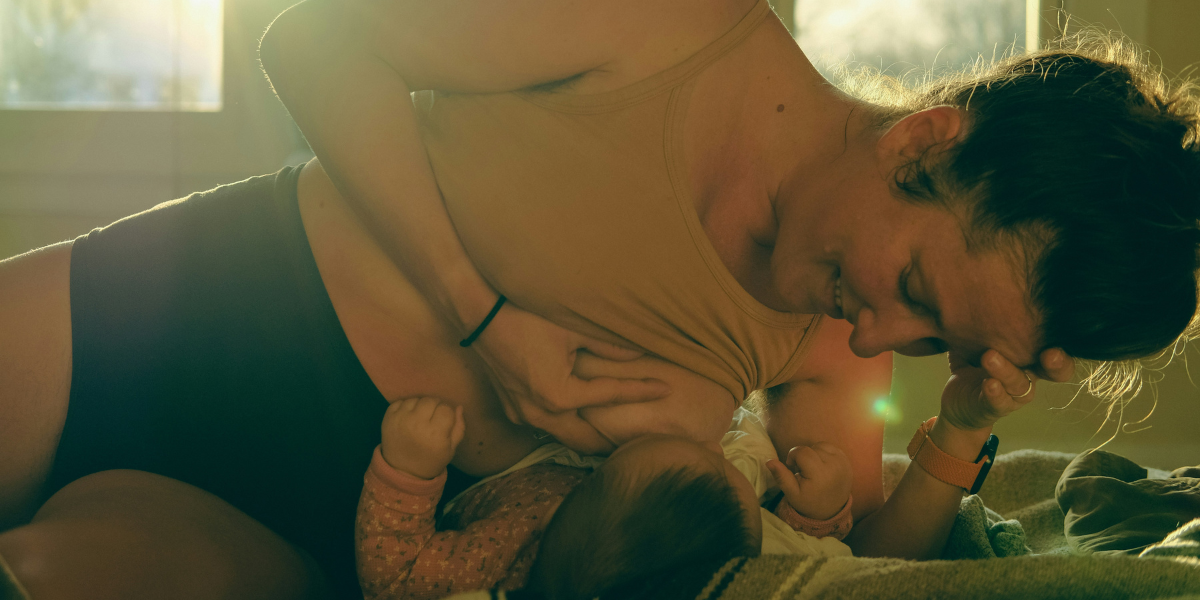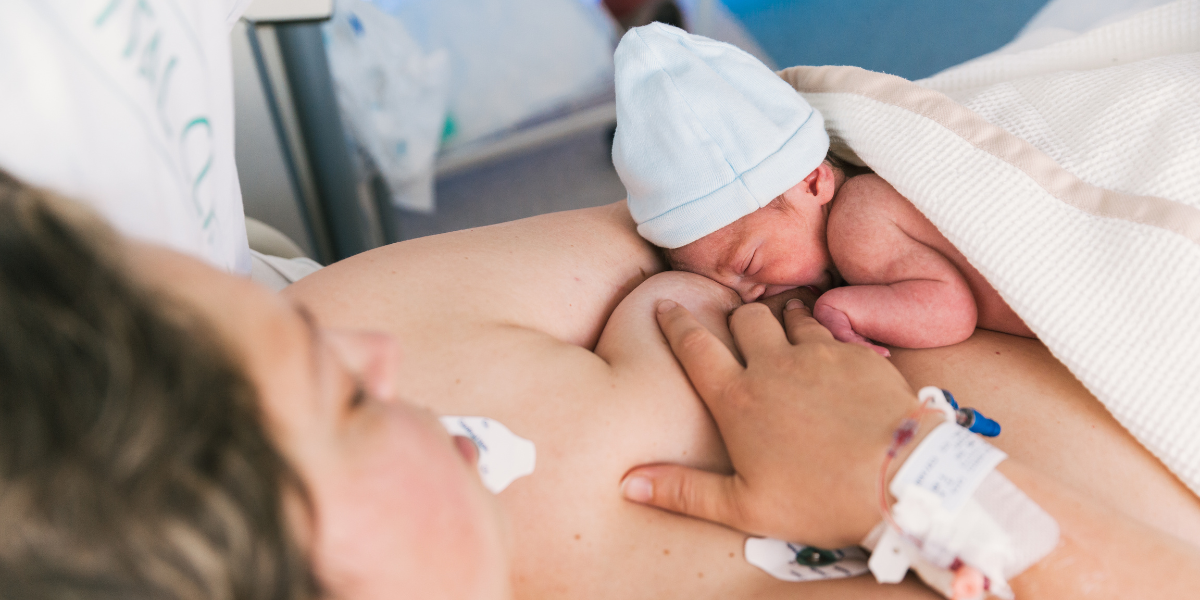Breastfeeding is one of the most natural ways to feed your newborn. By breastfeeding, you protect your baby's health and ensure that you both build a very special and deep bond with each other. But breastfeeding your newborn can be challenging, especially at the beginning. In the following article, you will find out how to get started with breastfeeding and what you should pay attention to when breastfeeding.
Prepare for breastfeeding during pregnancy
You can prepare for breastfeeding even before the birth. Find out about breastfeeding techniques and positions, e.g. in a birth preparation course, through books, on the Internet or from your midwife. Knowing what to expect can give you security.
Around twelve days before birth, the first colostrum forms in your breasts. You can collect the milk, which can contain up to 40 ml, in small milk containers and cool it or even freeze it to give to your baby after birth. The yellowish and viscous colostrum provides your baby with plenty of proteins and vitamins after birth. The colostrum is low in fats and carbohydrates and is therefore easy for your newborn to digest.
The first breastfeeding after birth
After your baby is born, ideally you will have him or her placed directly on your chest so that you can get to know each other in peace. The first time you breastfeed should take place around the first hour after birth. A good time to breastfeed is when your upper body is bare and your baby is naked. This allows your baby to use its innate climbing and spreading reflexes to find support on your body and become active itself: your baby searches for your breast with head movements and when it has found it, it lifts its head, opens its mouth and can latch on independently or with a little help from you. Your baby's sucking reflex helps stimulate milk production. If breastfeeding doesn't work straight away after birth, ask a midwife for help and try to stay relaxed.
Breastfeeding after birth - with support it works
With pregnancy and birth, not only does the anticipation of your baby grow, but sometimes so does the uncertainty or fear of doing something wrong. Don't worry, that's completely normal. You will definitely get support and advice from your midwife. There may even be breastfeeding consultants in the place where you give birth who can show you the best way to latch on after the birth. You can also look for a breastfeeding group in your area early on. Talking to other mothers, watching your baby at the breast and getting tips can help you start breastfeeding.
Easy start to breastfeeding through correct attachment
There are different positions for breastfeeding and what works for one mother may not necessarily be right for you. Try different positions to see what is most comfortable for you and your baby. With a nursing pillow you can make it really comfortable for you and your baby. The right positioning technique can make starting to breastfeed much easier:
1. Preparing to breastfeed
Hold your baby close to your body with his nose pointing toward your nipple. To stimulate the search reflex, you can touch his lips or the area above the upper lip with your breast. When your baby opens his mouth, guide him to your breast.
2. Drink
You can tell whether your baby is latching on properly by the fact that the upper and lower lips are turned up and that it has small chubby cheeks. So that your baby can drink well, it should have a good grip on your nipple and part of the areola. This makes sucking easier. If breastfeeding feels uncomfortable, hurts or you hear smacking noises, stop briefly and find a new position. Always stay calm and relaxed, even if it doesn't always work right away at the beginning.
3. After breastfeeding, loosen
Your baby will usually let go of the breast on its own when it has had enough to drink. If your baby continues to suckle for a long time without drinking, you can gently place your little finger in the corner of the mouth to stop the sucking process. This will allow your baby to let go of the breast very easily.
What is the right amount to drink when starting breastfeeding?
Your baby is born with a hazelnut-sized stomach, so in the first few days, small amounts of colostrum are enough to keep your baby full. Later, when you produce more milk, your baby will be able to digest larger amounts - up to 800 ml a day. Your milk supply always depends on your baby's demand. This can sometimes be more, sometimes less. It is important that your baby seems satisfied and is gaining weight. By the way: did you know that depending on the time of day, not only the amount of milk but also the composition of the milk changes?
How often should I breastfeed my newborn?
Breastfeed your baby as needed when he or she shows signs of hunger. Breastfeeding volume is increased, particularly at the beginning, at eight to twelve times a day. Frequent breastfeeding also stimulates the breast and encourages milk production. As your child gets older, the intervals between feedings also increase. You can expect breastfeeding to last around 15 to 20 minutes, but this varies from baby to baby.
How do I know if my baby is hungry?
Breastfeeding is easier for you and your baby if you recognize the early signs of hunger:
- Your baby licks his lips and moves his head.
- Your baby smacks and sucks on his hand.
- Your baby makes noises, becomes whiny and moans slightly.
- Your baby sticks out his tongue when he wants to suck.
If your baby is already crying, this is one of the late signs of hunger. It can then be difficult to breastfeed the baby correctly. Therefore, always pay close attention to your child, cuddle with him a lot and hold him securely in your arms to notice early signs. You will notice: Breastfeeding works so much better without stress.
How do I know if my baby is full?
You will know that your baby is drinking enough if, from the fifth or sixth day onwards, your baby has six or more wet diapers and two or more full diapers a day. If your baby is gaining weight well, you can be sure that your baby is getting enough fluids and calories. If your baby lets go of the breast, it is full.
Do I have enough breast milk for my baby?
Especially at the beginning of breastfeeding, many mothers worry about whether their breast milk is enough. But these worries are often unfounded, because the amount of milk always adapts to your baby's needs. Your breasts can also feel fuller and emptier at times. But that does not indicate how much breast milk you are producing. You can assume that your baby is drinking enough if it...
- ... is continuously increasing,
- ... has a healthy skin color,
- ... is satisfied and
- ... has around six wet diapers a day and from the fourth day of life three diapers with stools a day.
Note: The number of diapers indicated may vary daily.
What should I pay attention to in my diet?
To make breastfeeding a pleasant experience for you and your baby, you should place great value on a balanced diet. Above all, eat foods rich in vitamins and nutrients and drink plenty of water or tea. When breastfeeding, your calorie needs can increase to an additional 500 to 600 kcal per day. With healthy fats from nuts, seeds, avocados and oils, for example, as well as enough proteins and carbohydrates, you can be sure that you are consuming enough calories. Many mothers also notice that they are more hungry when breastfeeding and intuitively eat more than usual. Of course, you can also treat yourself to chocolate, ice cream or another favorite snack of your choice.
Believe in yourself and your baby
Breastfeeding is a personal journey and every experience is unique. Be patient with yourself and your baby as you both adjust to this new phase of life. And even if it isn't easy at the moment, your baby cries a lot or can't take the breast: remind yourself that you can do it, that you are strong and that you are 100 percent devoted to your baby and that you are doing your best every day. With time and practice, breastfeeding will become easier, more routine and a natural and fulfilling experience.






Leave a comment
All comments are moderated before being published.
This site is protected by hCaptcha and the hCaptcha Privacy Policy and Terms of Service apply.